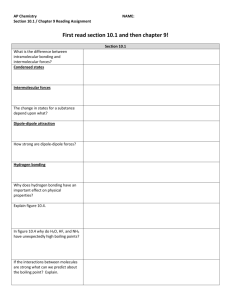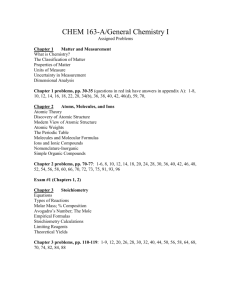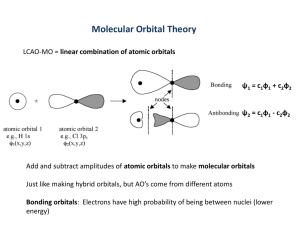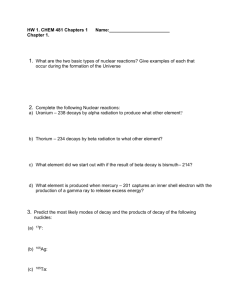Chapter 6: CHEMICAL BONDING AND STRUCTURE
advertisement
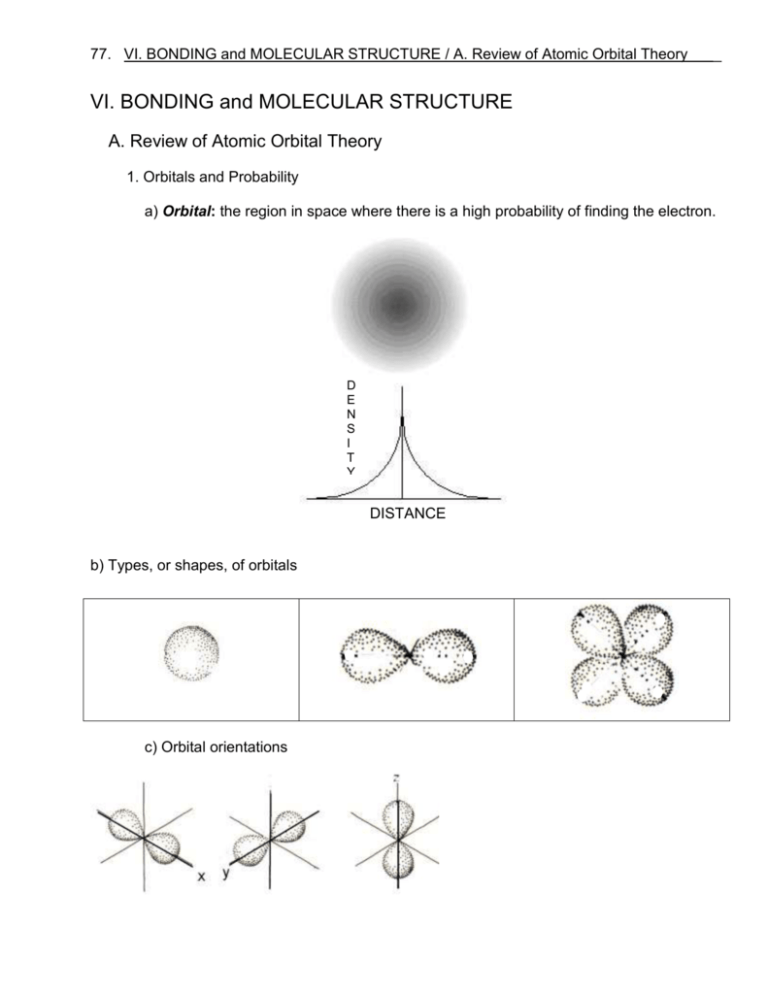
77. VI. BONDING and MOLECULAR STRUCTURE / A. Review of Atomic Orbital Theory _ VI. BONDING and MOLECULAR STRUCTURE A. Review of Atomic Orbital Theory 1. Orbitals and Probability a) Orbital: the region in space where there is a high probability of finding the electron. D E N S I T Y DISTANCE b) Types, or shapes, of orbitals c) Orbital orientations 78. VI. BONDING and MOLECULAR STRUCTURE / A. Review of Atomic Orbital Theory Type # Orientations Designations d) Any single orbital has a maximum capacity of two e- ‘s 2. Orbitals and Energy a) Orbitals: are sub-energy levels of the principal levels predicted by Bohr. b) Number of orbitals per principal level = n2 e.g. the 3rd energy level hold 18 e- ‘s (2 32). To hold 18 e- ‘s you need 9 orbitals since each orbital can only hold two e- ‘s. _ 79. VI. BONDING and MOLECULAR STRUCTURE / A. Review of Atomic Orbital Theory c) Energy level diagram E n e r g y _ 80. VI. BONDING and MOLECULAR STRUCTURE / A. Review of Atomic Orbital Theory 3. Electron Configuration Using the Energy Diagram Example(1): Give the electron configuration of 1H. Example(2): Give the electron configuration of 2He. a) Pauli exclusion principle: no two electrons in an atom can be exactly alike. There are 4 distinguishing factors for an electron: i) principal energy level ii) orbital type iii) orbital orientation iv) spin b) Hund's rule: Given a chance electrons will remain unpaired. Example(3): Give the electron configuration of 6C. Example(4): Give the electron configuration of 8O. Example(5): Give the electron configuration of 19K. _ 81. VI. BONDING and MOLECULAR STRUCTURE / A. Review of Atomic Orbital Theory _ 4. Electron Configuration and Periodic Table a) Relationship of orbital theory to the structure of the periodic table On the blank periodic table, write in the last occupied orbital for each element and the number of electrons in the orbital level. (e.g. the complete configuration of 6C is 1s22s22p2. Under 6C write ... 2p2 . (The three dots means all lower level orbitals are completely filled.) You will soon see the relation between the orbitals and the structure of the table. 82. VI. BONDING and MOLECULAR STRUCTURE / A. Review of Atomic Orbital Theory _ 5. Electron Configuration Using the Periodic Chart s p 1 2 d 3 4 5 6 7 Example(6): Write the complete electron configuration of 11Na, using the periodic table to determine the order of orbital filling. Example(7): Write the complete electron configuration of 33As, using the periodic table to determine the order of orbital filling. 6. Relative Energy of Orbitals Using the Periodic Table Example(8): Which orbital has the higher energy, 3s or 3p? Example(9): Which orbital has the highest energy, 3s, 3p, 3d, or 4s? 7. Valence Configuration Example(10): Determine the valence configuration of 12Mg. 83. VI. BONDING and MOLECULAR STRUCTURE / A. Review of Atomic Orbital Theory Example(11): Determine the valence configuration of 32Ge. Example(12): Determine the valence configuration of 83Bi. Be able to do valence configurations for all atoms in the main groups, using the periodic table as your guide. 8. Number of Unpaired Example(13): Determine the number of unpaired electrons in 27Co. Example(14): Determine the number of unpaired electrons in 44Ru. Example(15): Determine the number of unpaired electrons in 50Sn. _ 84. VI. BONDING and MOLECULAR STRUCTURE / B Valence Bond Theory _ B. Valence Bond Theory 1. Valence Bond Theory: the bond between 2 atoms is the result of the overlap of their atomic orbitals. Example(1): a) How is the covalent bond formed between 2 hydrogen atoms. b) How does this hold the atoms together. c) Draw an energy diagram showing how the energy of the atoms varies with the distance between them. d) On the diagram indicate the bond length. Example(2): Explain why a bond between two helium atoms cannot be formed in the same way. 85. VI. BONDING and MOLECULAR STRUCTURE / B Valence Bond Theory 2. Sigma Bonds: The increase in the electron density lies directly between the two nuclei. Example(3): Show how is the covalent bond is formed between two fluorine atoms. Example(4): Show how is the covalent bond is formed between a hydrogen and a fluorine atom. Example(5): Show how is the covalent bonds are formed between two hydrogen atoms and one selenium atom. _ 86. VI. BONDING and MOLECULAR STRUCTURE / B Valence Bond Theory 3. Pi Bonds: The increase in the electron density lies above and below the axis connecting the two nuclei. Example(6): Show how the covalent bonds are formed between two oxygen atoms. Example(7): Show how the covalent bonds are formed between two nitrogen atoms. _ 87 VI. BONDING and MOLECULAR STRUCTURE / C. Hybridization _ C Hybridization of Orbitals 1. Hybridized Orbitals: are the result of “mixing” different orbital types together. (The wave functions are added together to give new wave functions.) Example(1): a) In its ground state, how many bonds can a carbon atom form? b) In it first excited state, how many bonds can a carbon atom form? c) In CH4 all of the bond angles are equal, what can be concluded about the carbon’s orbitals 2p ___ ___ ___ 2p ___ ___ ___ 2s ___ 2s ___ ___ ___ ___ ___ ground state excited state hybridized state Single sp3 orbital Example(2): a) In its ground state, how many bonds can a boron atom form? b) In it first excited state, many bonds can a boron atom form? c) In BCl3 all of the bond angles are equal, what can be concluded about the boron’s orbitals 2p ___ ___ ___ 2p ___ ___ ___ 2s ___ 2s ___ ___ ___ ___ ___ ground state excited state hybridized state 88 VI. BONDING and MOLECULAR STRUCTURE / C. Hybridization _ Example(3): a) In its ground state, how many covalent bonds can a beryllium atom form? b) In it first excited state, how many bonds can a beryllium atom form? c) In BeH2 the bond angle between the H’s is 180º, what can be concluded about the beryllium’s orbitals 2p ___ ___ ___ 2p ___ ___ ___ ___ ___ ___ ___ 2s ___ ground state 2s ___ excited state hybridized state Example(4): In its ground state sulfur has only 2 unpaired electrons. But S can form SCl6. How does S achieve 6 unpaired electrons? 3d ___ ___ ___ ___ ___ 3d ___ ___ ___ ___ ___ 3p ___ ___ ___ 2p ___ ___ ___ 3s ___ 2s ___ ___ ___ ___ ___ ___ ___ ___ ___ 89 VI. BONDING and MOLECULAR STRUCTURE / C. Hybridization _ 2. Predicting hybridization from dot formulas Example(5): a) Do the dot formula of NH3. b) The bond angle between the H’s is a little less than 109º. What can be concluded about the orbitals that the N atom uses? c) Draw the orbital levels for the ground state and the hybridized state for nitrogen in NH3. 90 VI. BONDING and MOLECULAR STRUCTURE / C. Hybridization _ Example(6): a) Do the dot formula of H2O. b) The bond angle between the H’s is much greater than 90º, but a little less than 109º. What can be concluded about the orbitals that the O atom uses? c) Draw the orbital levels for the ground state and the hybridized state for oxygen in H2O. 3. Pi bonds in hybridized atoms. Example(7): a) Do the dot formula of C2H4. b) All of the bond angles around each carbon atom are about 120º. What can be concluded about the hybridization of the carbon’s orbitals forming the sigma bonds? c) Draw the orbital levels for the ground state and the hybridized state for the carbons. d) How is the pi bond formed? 91 VI. BONDING and MOLECULAR STRUCTURE / C. Hybridization Example(8): a) Do the dot formula of C2H2. b) The bond angle around each carbon atom are about 180º. What can be concluded about the hybridization of the carbon’s orbitals forming the sigma bonds? c) Draw the orbital levels for the ground state and the hybridized state for the carbons. d) How are the two pi bond formed? _ 92 VI. BONDING and MOLECULAR STRUCTURE / C. Hybridization _ 4. Summary of Central Atom Hybridization and Molecular Shapes Areas of Electrons Around the Central Atom Hybridization Attached Atoms, Lone Pairs Example Molecular Shape Example FOUR sp3 4 atoms, 0 pair Tetrahedral CCl4 FOUR sp3 3 atoms, 1 pair Trigonal Pyramidal PH3 FOUR sp3 2 atoms, 2 pair Bent or “V” Shape SCl2 FOUR sp3 1 atom, 3 pair Linear HF THREE sp2 3 atoms, 0 pair BBr3 SO3 THREE sp2 2 atoms, 1 pair Trigonal Planer Bent or “V” Shape BCl2‾ SO2 TWO sp 2 atoms, 0 pair Linear BeCl2 FIVE sp3d 5 atoms, 0 pair Trigonal Bipyramidal PCl5 SIX sp3d2 6 atoms, 0 pair Octahedral SF6 SIX sp3d2 4 atoms, 2 pair Square Planer XeF4 93 VI. BONDING and MOLECULAR STRUCTURE / C. Hybridization _ 5. Molecular Polarity a) Polar Bond: the unequal sharing of electrons between two atoms. The greater the EN difference between the two atoms, the more polar the bond. b) Polar Molecule: has a partially positive end opposite a partially negative end (a dipole). Example(9): For each of the example molecules in the summary table above, determine if the molecule is polar or nonpolar. 94 VI. BONDING and MOLECULAR STRUCTURE / D. Molecular Orbital Theory _ D. Molecular Orbital Theory 1. Molecular orbital theory assumes that around a set of nuclei there are a series of orbitals. These orbitals have different shapes and different energies. (This is analogous to atomic orbital theory: around a nucleus there are a series of atomic orbitals, with different shapes and energies.) 2. To approximate the molecular orbitals (MO’s), the atomic orbitals (AO’s) are combined together mathematically. There are two ways to combine the AO wave functions, they can be added or subtracted. a) “s” AO’s Two Separate Wave functions Wave functions Added Bonding Orbital Wave functions Subtracted Antibonding Orbital 95 VI. BONDING and MOLECULAR STRUCTURE / D. Molecular Orbital Theory b) “p” AO’s can be combined together in the same way. i) Sigma MO’s. If the AO’s are along the axis connecting the 2 nuclei, you get a sigma bonding MO (σ 2p) and a sigma antibonding MO (σ* 2p). Bonding Orbital Antibonding Orbital ii) Pi MO’s. If the AO’s are perpendicular to the axis connecting the 2 nuclei, you get a pi bonding MO (π 2p) and a pi antibonding MO (π* 2p). Bonding Orbital Antibonding Orbital 3. Conservation of Number of Orbitals. If you start with 2 AO’s you get 2 MO’s. If you start with 3 AO’s you get 3 MO’s, etc. 4. Energy Level Diagrams a) H2 σ* 1s 1s 1s σ 1s _ 96 VI. BONDING and MOLECULAR STRUCTURE / D. Molecular Orbital Theory b) O2 and F2 σ* 2px π* 2py px py π* 2pz pz pz π 2py py px π 2pZ σ 2px σ* 2s 2s 2s σ 2s c) Li2 to N2 σ* 2px π* 2py π 2pz σ 2px π 2py π 2pz σ* 2s σ 2s _ 97 VI. BONDING and MOLECULAR STRUCTURE / D. Molecular Orbital Theory _ 5. Molecular Electron Configuration and Bond Order (BO). a) Determining molecular electron configuration from the above energy diagrams. As with atomic electron configuration, one starts at the lowest energy level and fills it completely before moving to the next highest available level. When 2 electrons occupy the same energy level they must have opposite spins (Pauli’s Exclusion Principle). When there is more than one MO with the same energy, the electrons stay unpaired if possible (Hund’s Rule). b) Determining bond order (BO) BO = # bonding electrons – # antibonding electrons 2 Example(1): Determine the molecular electron configuration and the BO for H2 Example(2): Prove that the BO for He2 is zero. Example(3): Determine the molecular electron configuration and the BO for N2 Example(4): a) Determine the molecular electron configuration and the BO for O2. b) How many unpaired electrons are in the O2 molecule?

